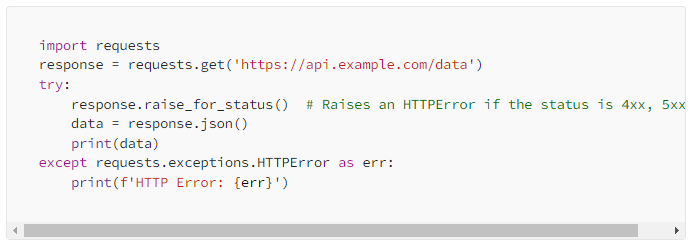반응형
1. Basic GET Request
To fetch data from an API endpoint using a GET request:
import requests
response = requests.get('https://api.example.com/data')
data = response.json() # Assuming the response is JSON
print(data)2. GET Request with Query Parameters
To send a GET request with query parameters:
import requests
params = {'key1': 'value1', 'key2': 'value2'}
response = requests.get('https://api.example.com/search', params=params)
data = response.json()
print(data)3. Handling HTTP Errors
To handle possible HTTP errors gracefully:
import requests
response = requests.get('https://api.example.com/data')
try:
response.raise_for_status() # Raises an HTTPError if the status is 4xx, 5xx
data = response.json()
print(data)
except requests.exceptions.HTTPError as err:
print(f'HTTP Error: {err}')4. Setting Timeout for Requests
To set a timeout for API requests to avoid hanging indefinitely:
import requests
try:
response = requests.get('https://api.example.com/data', timeout=5) # Timeout in seconds
data = response.json()
print(data)
except requests.exceptions.Timeout:
print('The request timed out')5. Using Headers in Requests
To include headers in your request (e.g., for authorization):
import requests
headers = {'Authorization': 'Bearer YOUR_ACCESS_TOKEN'}
response = requests.get('https://api.example.com/protected', headers=headers)
data = response.json()
print(data)6. POST Request with JSON Payload
To send data to an API endpoint using a POST request with a JSON payload:
import requests
payload = {'key1': 'value1', 'key2': 'value2'}
headers = {'Content-Type': 'application/json'}
response = requests.post('https://api.example.com/submit', json=payload, headers=headers)
print(response.json())7. Handling Response Encoding
To handle the response encoding properly:
import requests
response = requests.get('https://api.example.com/data')
response.encoding = 'utf-8' # Set encoding to match the expected response format
data = response.text
print(data)8. Using Sessions with Requests
To use a session object for making multiple requests to the same host, which can improve performance:
import requests
with requests.Session() as session:
session.headers.update({'Authorization': 'Bearer YOUR_ACCESS_TOKEN'})
response = session.get('https://api.example.com/data')
print(response.json())9. Handling Redirects
To handle or disable redirects in requests:
import requests
response = requests.get('https://api.example.com/data', allow_redirects=False)
print(response.status_code)10. Streaming Large Responses
To stream a large response to process it in chunks, rather than loading it all into memory:
import requests
response = requests.get('https://api.example.com/large-data', stream=True)
for chunk in response.iter_content(chunk_size=1024):
process(chunk) # Replace 'process' with your actual processing function
반응형
'프로그래밍 > Python' 카테고리의 다른 글
| [python] TIOBE Index for August 2024, Python 1st (0) | 2024.08.09 |
|---|---|
| [python] Working With Lists (0) | 2024.07.24 |
| [python] Working With Files (0) | 2024.07.24 |
| [python] Pandas cheat sheet (0) | 2024.07.19 |
| [python] 변수 scope, LEGB Rule (0) | 2024.07.15 |
